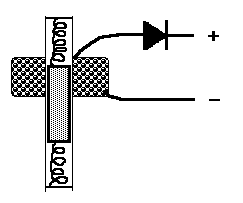GreenAce92
Member level 4

- Joined
- May 6, 2010
- Messages
- 70
- Helped
- 0
- Reputation
- 0
- Reaction score
- 0
- Trophy points
- 1,286
- Location
- Buffalo, NY
- Activity points
- 2,032
You're probably aware of those flashlights that you shake, I've been fortunate to have seen a transparent version which showed the coils and the sliding magnetic core. The coil was say a 1/3 of the cylinder which housed the possible sliding ability of the magnet core.
I was wondering if the coil was the entire length of sliding eg. the whole time the magnet core was sliding, it was always inside the coil, would it generate electricity? Probably a trivial question.
My next question is, given the way the magnetic field "propagates?" from the magnetic core eg. north to south, in a axial/radial symmetry, would it make more sense to arrange smaller coils with their centers positioned around the circumference of a larger circle which is concentric with the magnetic core. This way the radiating lines would go directly or mostly into the entire area of the coils, rather than... well actually maybe it is better to envelope the entire magnetic core with one large-diameter coil as all of the field will be captured when the magnetic core is near the opening of the coil.
See the diagram attached for clarification.
My other concern was regarding a wave-generator design which is not like that design of a floating body, with a pendulum attached hanging below the surface of the water. I think that is a great design. What I'm talking about is using the same idea above of a sliding object, but instead of using the coils idea, design it like an old Grandfather gravity clock. I'm not sure if this has any benefits over the pendulum design but the idea would be a link of these, like the lane line dividers in a pool.
Anyway, regardless of orientation both ends of the generator or perhaps it is one loop with one generator, would start to turn and make energy as the floating buoy rocked and pivoted in waves.
I'm just not sure it would be better to have a more free, faster moving design like the one shown above, where there are no lines attached, and it's a magnet core going through a coil, rather than a weight pulling on motors.
I'd appreciate your thoughts.
The shell competition thing is interesting to me, I was thinking about floating charging stations, like floating solar panels possibly combined with wave/wind based or each are separate, and these submerge in the event of a storm or passing boat (sorry getting off topic).
I apologize I did not bust out 3D rendering, I was simply trying to get the point across.
I was wondering if the coil was the entire length of sliding eg. the whole time the magnet core was sliding, it was always inside the coil, would it generate electricity? Probably a trivial question.
My next question is, given the way the magnetic field "propagates?" from the magnetic core eg. north to south, in a axial/radial symmetry, would it make more sense to arrange smaller coils with their centers positioned around the circumference of a larger circle which is concentric with the magnetic core. This way the radiating lines would go directly or mostly into the entire area of the coils, rather than... well actually maybe it is better to envelope the entire magnetic core with one large-diameter coil as all of the field will be captured when the magnetic core is near the opening of the coil.
See the diagram attached for clarification.
My other concern was regarding a wave-generator design which is not like that design of a floating body, with a pendulum attached hanging below the surface of the water. I think that is a great design. What I'm talking about is using the same idea above of a sliding object, but instead of using the coils idea, design it like an old Grandfather gravity clock. I'm not sure if this has any benefits over the pendulum design but the idea would be a link of these, like the lane line dividers in a pool.
Anyway, regardless of orientation both ends of the generator or perhaps it is one loop with one generator, would start to turn and make energy as the floating buoy rocked and pivoted in waves.
I'm just not sure it would be better to have a more free, faster moving design like the one shown above, where there are no lines attached, and it's a magnet core going through a coil, rather than a weight pulling on motors.
I'd appreciate your thoughts.
The shell competition thing is interesting to me, I was thinking about floating charging stations, like floating solar panels possibly combined with wave/wind based or each are separate, and these submerge in the event of a storm or passing boat (sorry getting off topic).
I apologize I did not bust out 3D rendering, I was simply trying to get the point across.




